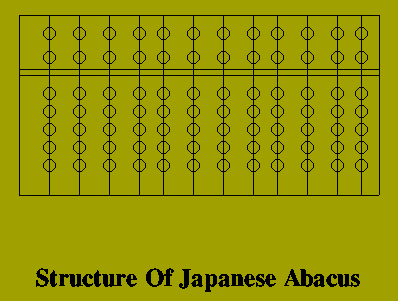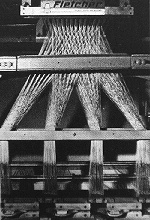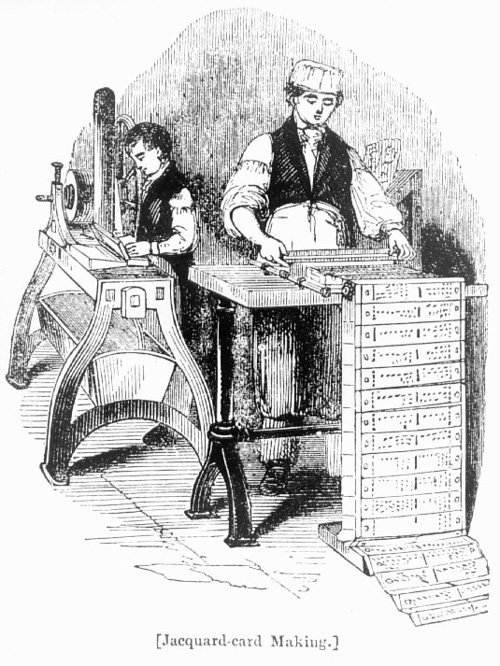Lesson 3b: Inventions of Counting Tools:

|
|

The Abacus
The Chinese invented the Abacus 4,000 years ago.
It was the first
machine for counting and calculating.
It is made from a wooden frame,
metal rods and wooden
beads. It takes a lot of practice to learn how to
use the
abacus. The abacus is used in China and other Asian
countries to
count and calculate, just like we use calculators.

|
How to use an Abacus:
Each bead has a specific value. Reading from right to left, the beads in the
first column are worth 1, in the second column the beads are worth 10, in
the third column the beads are worth 100, etc. Addition, subtraction,
multiplication, and division are performed by moving the appropriate beads
to the middle of the abacus.


 Assignments Assignments
Web Sites:
Check this link out for information on invention of Calculating Machines.
You will find the answers for your assignments on these web sites.

|

The Pascaline
The Pascaline was invented by a French mathematician named Blaise
Pascel in 1642. He was 19 when he invented the first mechanical and
automatic calculator. Pascal father was a tax accountant and he was trying
to make his father's job easier.


 Assignment: Assignment:
Web Sites: Blaise
Pascal
Technology Lab: 
Using Apple Works 6: Word Processing answer these questions.
Save
your work in your student work folder. Title
your work: YourLastName_answers_pascal
1. Why did Blaise Pascel create his machine?
2. What was the Pascaline?
3. How long did it take Blaise Pascel to develop the
machine?
4. What jobs did Blaise Pascel do?
5. His name is immortalized by what?


Leibniz Calculator

In 1673, a German inventor named Gottfried
Leibniz perfected the Leibniz
Calculator. It was a calculating machine but much superior to the
Pascaline.
It could also multiply, divide and find square roots of numbers. Remember the Pascaline could only add and subtract.
The Leibniz was mechanical and worked by hand. He added a crank to speed up the work on this calculator. Mathematicians and bookkeepers used this calculator. Mr. Leibniz
believed that it didn't make sense for men to spend hours doing mathematical calculations when he could invent a machine that would work much faster.
Think about it ..would you rather add a long list of numbers with  a pencil and paper or use a calculator?
a pencil and paper or use a calculator?


|
|

 Assignments Assignments
|
 
Technology Lab: Using
Apple Works 6: Word Processing answer these questions.
Save
your work in your student work folder. Title
your work: YourLastName_answers_leibniz
1. Why are things invented?
2. Check out the web site of Gottfried Leibniz to see if he invented
anything else.
3.Do further research on Gottfried Leibniz and his calculator. Write a
short report using the word processor on your computer.

|
|
 Jacquard Loom Jacquard Loom
|
Joseph-Marie Jacquard was a French weaver whose job was very hard. He had to do several tasks at the same time to make a piece of cloth. In 1801 he invented the Jacquard Loom.
It was a weaving machine that was controlled by punched cards. While the loom was pumped , cards with holes in them were attached together in a pattern through which strings
of thread were automatically fed. These cards would feed the right pieces of thread into the thread into the loom to make the cloth.
The introduction of these looms caused the riots against the replacement of people by machines. Weavers today still use the Jacquard Loom as it makes
cloth faster and better.


|

 Assignments: Assignments:
 
|
|
Using Apple Works 6: Word Processing answer these questions.
Save
your work in your student work folder. Title
your work: YourLastName_answers_jacquard
1.Why would an invention which makes your job
easier cause people to riot as the people did when Joseph-Marie
Jacquard invented the Jacquard Loom?
2.Why would the Jacquard Loom be important in the
invention and development of computers.

|
|
|







 Jacquard Loom
Jacquard Loom
 Web Sites
Web Sites